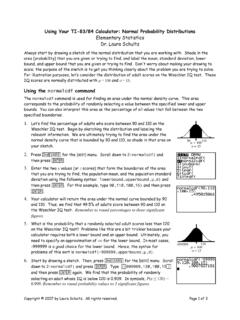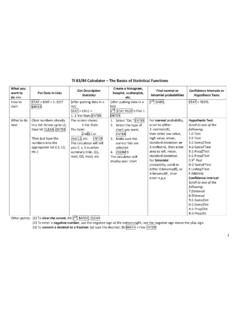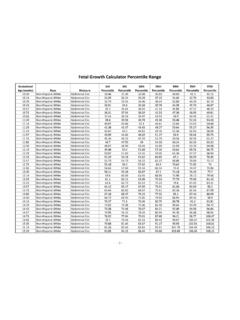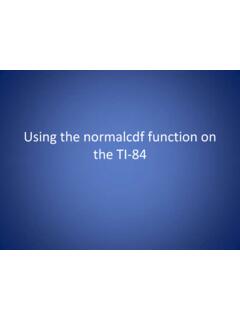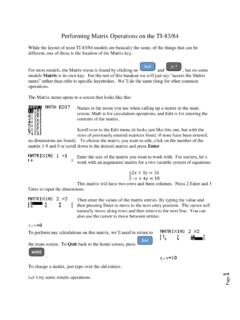Transcription of Checking Your Integrals on a TI-84 Handheld Calculator
1 Checking Your Integrals on a TI-84 Handheld Calculator Leon Hostetler P a g e | 1 (CC BY-SA ) Leon Hostetler, July 2014 Integration is often a fairly arduous maths exercise, and we are prone to making silly algebra errors when doing them. Wouldn t it be nice if we had an easy way of Checking our solutions? Checking Integrals , especially indefinite Integrals , is not always a straightforward thing to do on a Handheld Calculator . Fortunately, there are some cool tricks that allow us to do just that making our Calculator an integral part of working with Integrals .
2 These techniques are the key to preventing silly integration errors and the key to getting 100% on your undergraduate calculus exams. Definite Integrals .. 2 Method 1 .. 2 Method 2 .. 3 Indefinite Integrals .. 4 Vertical asymptote at one of your limits .. 5 Vertical Asymptote Inside your Limits .. 6 Decimal Accuracy .. 6 Improper (Vertical Asymptote) Integrals .. 7 Improper (Horizontal Asymptote) Integrals .. 10 Credits .. 12 P a g e | 2 (CC BY-SA ) Leon Hostetler, July 2014 Definite Integrals There are two ways of Checking definite Integrals on the TI-84 .
3 Method 1 This is the most straight forward procedure because you can enter the integral as shown in your textbook or exam. To use this method go to MATH then 9:fnInt( on your TI-84 . Type in your integral and the limits and press enter. Here s an example integrating : The actual answer is 1/120, which is approximately equal to .0083333333. Note: The TI-84 only gives decimal answers for definite Integrals , so you still have to do the actual work to get the exact answer. The TI-84 is only useful to check your final answer or to verify that you re on the right track. P a g e | 3 (CC BY-SA ) Leon Hostetler, July 2014 Method 2 Method 2 has the advantage of showing you a graph and interpreting the definite integral as the area under the graph.)
4 One drawback is that this method is not quite as accurate as the earlier method. To use this method, start by graphing the integrand. Then go to 2ND then TRACE/CALC then select option number 7. Here s the same integral that we did earlier using this second method: As soon as the Calculator finishes drawing the graph, it asks for the lower limit which you key in then press ENTER. Then it asks for the upper limit, which you key in and press ENTER. Here you can see that we got the same answer, and this time we can visualize the integral as the shaded area under the graph. Note: For this integral, we had to adjust the window settings.
5 Using standard settings, the function can t be distinguished from the x-axis. P a g e | 4 (CC BY-SA ) Leon Hostetler, July 2014 Indefinite Integrals The stock TI-84 doesn t have the ability to calculate indefinite Integrals , but we can still check our work using the Fundamental Theorem of Calculus. Remember it? If not, here it is: The Fundamental Theorem of Calculus simply states that we can calculate the value of a definite integral by evaluating the antiderivative at a and subtracting that from the value of the antiderivative at b.
6 It sounds complicated but it s not. Here s how we can do it: First, we solve our definite integral . Now, we want to check to make sure our antiderivative F is the right answer, so we ll pretend that we solved a definite integral, by evaluating both the integral and the antiderivative at the same conveniently-chosen limits (using our Calculator ) and see if our answers match. Consider the following integral (on the left side of the equality) and our proposed solution (on the right side of the equality. How can we check our work by using our TI-84 and the Fundamental Theorem of Calculus?)
7 We do this by pretending it s a definite integral and seeing if the left side equals the right side: We start by doing a definite integration (using Method 1) of our function using some convenient values for a and b. In this case (see the picture below), we ve decided to integrate between 0 and 1. To check our answer, we evaluate our solution function ( our antiderivative) at 1 and 0, subtracting the first from the second. We could do this by entering the whole string of calculations into the Calculator , but there s a faster way of doing it.
8 We start by entering our antiderivative solution (without the C) as a function using the Y= button. Once the function has been entered we press 2ND then MODE/QUIT to exit that part of it. Next we evaluate our antiderivative at the top and bottom limits by clicking VARS, selecting the Y-VARS tab, selecting FUNCTION, selecting the function to be evaluated (Y1 in our case), typing a left bracket, entering the top limit, and closing the bracket. Then we hit the subtract key and use the same process to evaluate our antiderivative at the bottom limit. Before hitting the P a g e | 5 (CC BY-SA ) Leon Hostetler, July 2014 enter key, we should see on our screen.
9 Since we chose the limits of 0 and 1, our screen reads . This may seem like a long and complicated process, but after doing it a few times, you can check your indefinite Integrals in about 15 seconds. After hitting ENTER, we should see a decimal that matches the earlier decimal we got when doing the definite integration using Method 1. If the numbers aren t very close to equal, then our solution is wrong or we ve made a mistake when entering the stuff into the Calculator . Note: There are several things to keep in mind when using this method, and these are detailed in the next three sections.
10 Vertical asymptote at one of your limits Let s say you re doing a simple integration as follows: You want to check your integral by using the method detailed above and taking the limits of integration to be 0 and 1. When you enter the left side of the equation using the fnInt feature, the P a g e | 6 (CC BY-SA ) Leon Hostetler, July 2014 Calculator thinks, and thinks, and thinks, before it finally spits out ERR: TOL NOT MET. What went wrong? The problem is that has a vertical asymptote at 0, where the area under the curve heads off toward infinity, and the Calculator can t handle that.
